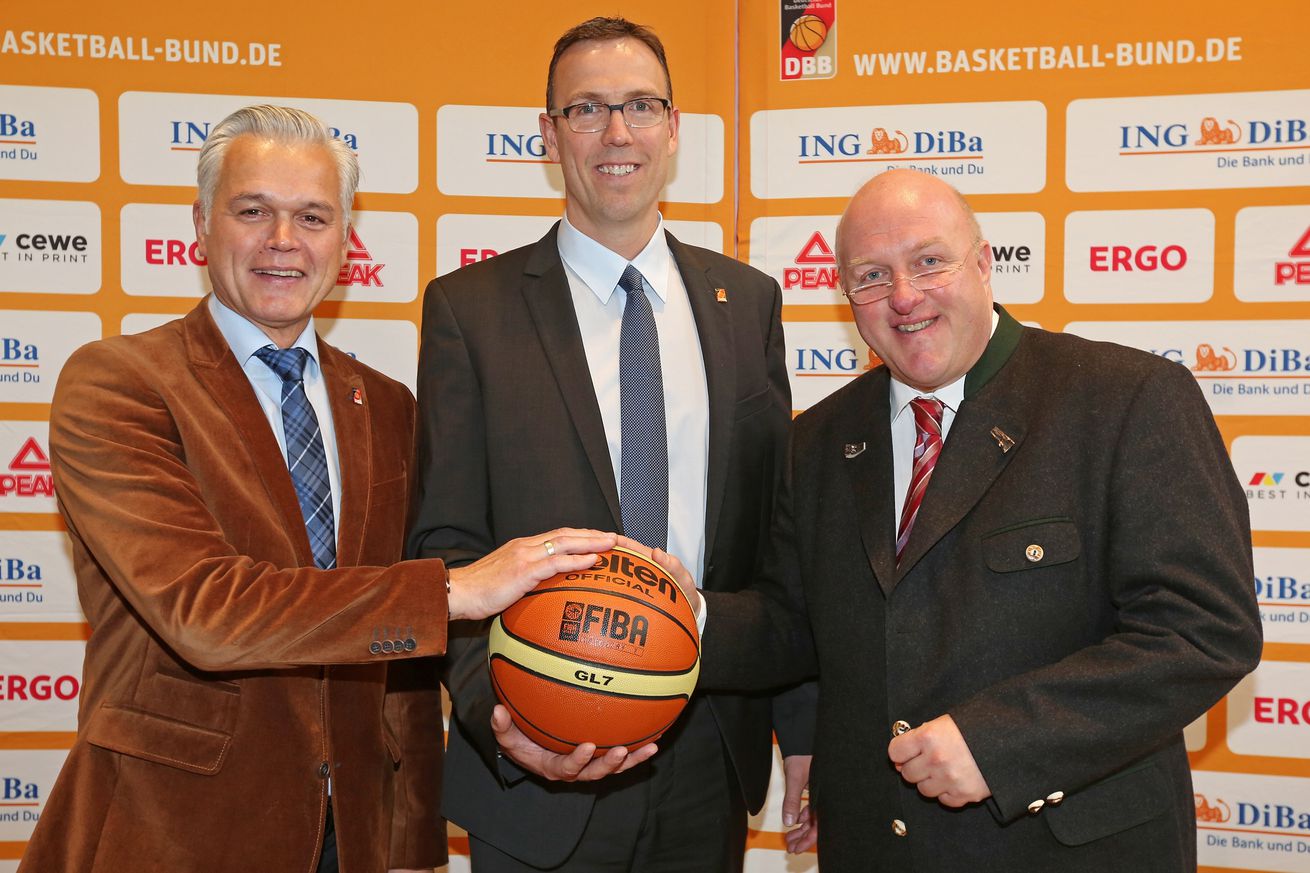The Denver Nuggets coaching staff took shape recently, and Chris Fleming's addition is an interesting one. He will be joining Michael Malone's staff in Denver, and leaving his post as the coach of the German Men's National Team, where he had been since Nov. of 2014. Fleming, a New Jersey native, is also a former player, having spent his entire professional career in Germany from 1994-2000. There was a bit of a kerfuffle with Fleming's acquisition that caused the Denver Post's Christopher Dempsey to elaborate on his status in a pair of tweets a few days ago:
Malone said he did not expect Fleming's commitment to the German National Team to be a problem at all in the future. #Nuggets
— Chris Dempsey (@dempseypost) July 6, 2015
and
#Nuggets coach Michael Malone said New asst. Chris Fleming will not join the team until Sept. after his obligations w/the German team end.
— Chris Dempsey (@dempseypost) July 6, 2015
But no one is contesting that Fleming is joining the staff. So, with that out of the way... what exactly will Chris Fleming bring to this team as its primary offensive mind?
Well, he happened to do a nice little 85 minute coaching speech for FIBA back in 2011, that laid out a lot of his principles of offense and the drills one would use to go about enacting this offense. Unfortunately, the FIBA website has lapsed in some places and the software is out of date, so it cannot be used to access the video.
So, I tracked down the video anyway and downloaded it. If you'd like to see some of the offensive sets he uses, here's a diagram-based link to some of the ways he utilized the pick n roll. That's a bit easier to see than the video - but if you'd like the entire video to download for yourself (about 800 megs) I'll send you a link to the file. The actual file was linked in some obscure place on http://coaching.fibaeurope.com, but since the video can't be watched there, I figured I could re-upload it if people want to see it.
If you don't wanna do that, here's a breakdown of some of the stuff he talked about over that hour-plus coaching instructional video. Keep in mind, he's talking to amateur coaches of youth players who are trying to get good tips, so this is not a masters-level course and some of it is quite elementary. Fewer dribbles means more scoring potential, more passes means the same, etc. Excessive iso-ball = backwards basketball offensively, especially from a team perspective. Dirk Nowitzki might do okay in isolation, but most of the team's players will suffer. That sort of thing.
That said, here are my notes on what he talked about (it would be better-written by me, but I'm out of time tonight and this has already taken too long, so suffer):
Structure
- Offensively, we don't wanna take the ball out of our PGs hands in the pick and roll if he's good at it and getting to the rack, but we should move the ball. The ball HAS to move.
- Defensively We have hard and structured rules. We do not have a lot of reads for our players (don't want the players to have to think a lot on D) so we drill it every day for how to defend transition / pick and roll / whatever. No gray area. It's clear to the guys what they're supposed to do. That way they can play hard knowing exactly what they're doing at any period of time.
- Offensively, we want to give them the tools and the structure to make decisions for themselves. Teach them to play in space the way we think it's important and then have them make decisions.
Offense is divided into 4 aspects
First is the transition game. He's not talking about the 3-on-2 or 4-on-3 break. We ought to attack if we have numbers, that's basic. When we're pushing the ball quickly are we attacking 5-on-5? We have to determine the tempo we wanna play at. Just remember: the quicker you want them to play, the less stuff they'll remember (quotes a book he read about making quick judgments by Malcolm Gladwell). It's about policemen who shot a guy who didn't do anything wrong, and because it was a bad neighborhood the cops had to make a very fast decision. When the policemen were interviewed they all had different interpretations of events and what was happening. That's how players are on the break - heart is going fast and you can't give them a lot to think about or they'll mess up. An exact quote from Fleming: "If you want them to play fast, make the rules easy."
Second is set offense structure. He doesn't bother going through many set plays in the instructional time, which I find interesting. Said Fleming, "If you want them, you can watch the first televised game and you'll see them all in the first quarter." Put your players in positions they like and can succeed in. The goal in the set play is not necessarily to score (you're ALWAYS allowed to score in our offense). Against good defenses, though, you're not going to score a lot of plays directly out of set offensive plays. You just want to gain a small advantage.
To get the defense to move themselves out of position just enough. We do care about cut timing and screen timing. Latest at the second pass we want a pick and roll or a post-up. "Not such a brilliant rule, everybody does it in modern basketball." Get your rules in short clock situations and DRILL them. Your players should know what to do with 4 seconds on the clock from the corner, or 12 seconds for a full-court. If you've got a time-out and wanna change it that's fine, but otherwise they should know what to do because it's been drilled.
Third are his offensive principles. Motion rules and how do we react after the set play has been run. How do we play? It can't be a free-for-all. Players have to know what's expected from them, but the players have the most freedom here to read the situation and understand what to do when.
Fourth part is individual skillwork. Reminder: It's about the players, not the coaches. If players just see plays drawn up on a board and they're drilled to just remember-remember-remember, then it becomes about the coach and not the player. Players need to know that coaches are willing to improve their offensive skillset to utilize them in the scheme. If you get guys with the right attitude, even more experienced players will improve if they're willing to work. Define for EACH player what they can do to help offensively. Players want to know: A.) what their role is (even if they don't like it) and B.) what you're gonna do to help them get better.
The rules of Fleming's offense
1) Make the ball see you (move and present a target or you won't get the ball).
2) Fill 4 perimeter spots at all times (there will be times where guys are involved in dribble penetration, etc). Once you pass the ball as a perimeter guy and you have to go back outside. Corner, foul-line extended, high elbow gives you six ossible places for those four guys to be - and only those spots..
3) Post-guy rules: if You're on the ball side, post above the block. Opposite the ball, then go behind the defense, as far down as possible to get the best spacing.
3a) The bigs step to the short corner inside the three, if there's dribble penetration in order to increase the spacing and the holes in the defense. If there's a baseline drive, the big has to use the free-throw line-extended as his goal. If there are guys who are not good from that spot there are things that can be done to make that work anyway.
4) Passing is crucial. Guys struggle feeding the post, but bigs HAVE to get the ball if they're open inside, and passers need to be taught HOW to get the ball in. Bounce-pass the post if you can, to get angles. In fact, for every pass available, define the type of pass you want used, otherwise you'll get passes you don't want.
4a) Talks about working footwork for the big receiving the pass, because his big man had trouble scoring it on the block because he wasn't ready to turn to the basket as the ball was received. The footwork helped clear that up. Also, the big man movement without the ball is basically the same in zone or man-to-man, so that the bigs always know what they're supposed to do. Removing confusion is the point.
5) On a baseline drive, the opposite corner 3 spot MUST be filled. Even if there's a teammate nearby on the baseline. Besides being a shorter shot, another reason the corner 3 is the highest percentage 3 is because it's the easiest pass. Let's guys catch and shoot in rhythm, and gives the guard the easiest pass to see.
6) When moving between spots, RUN, don't slide. This is in the drills being discussed, but also a focus for the games. Don't get lazy about re-positioning. Gotta maximize your little advantage you've gained with ball movement and penetrations.
6a) talks about the middle drive from the corner 3 spot as the best drive, because you can see the whole floor and all your passing options (Best court vision). There's nothing behind you.
Aside: I really enjoy watching his drill-work. "Throw the ball to yourself before starting the drill, so that you can hop and then go, get some momentum." Watching the players start to get it instead of walking through drills is fun. It's... crisp. There are a lot of drills going on for the next hour and I'm not gonna run through em all. Feel free to hit me up for a link to my Copy upload site to download and watch the video.
7) Transition game: Wing guys run the outside lanes to the corners. That's ALL they have responsibility for (again, part of keeping it simple in the fast break). The guard who advances the ball has to be outside the high elbow on one side, otherwise it's really hard to screen for him and get the best matchups. If the first big trailer is out ahead of the ball he will rim-run and ask for the ball. If that happens and we cannot get him the ball, then we will drag-screen with the remaining trailing big. Set the screen in the scoring area, and it should be an L-cut. Quality of the screen trumps the speed of it.
8) Pick n Roll rules: He is (in his own words) NOT a huge fan of slipping screens (and the crowd goes wild!), but wants you to jump into them and sprint out of them. They have to be SET, though. Speed in and speed out. Higher ball screens can have less contact time, and lower screens need to be held longer. One dribble pick and rolls from the guard. Drop the pocket pass to the rolling big QUICKLY if it's there.
Conclusion: If you want your guys to pass, and moving quickly out of the pick and roll, then define exactly what their looks are. That way they don't need a long time to decide what to do and the ball moves. It's a very passing-based offense.
**
Okay, really long post. If anybody made it through that, congrats! Here's a block of cheese and a foam finger. Don't confuse the two. The Nuggets should be more of a movement offense in the half-court, and with Nikola Jokic and Gallo they should do decently with the stretch big men helping our spacing.
I'm looking forward to seeing this mix of 1990s Jazz and 2010 Spurs in action. I just hope we can pull it off.




